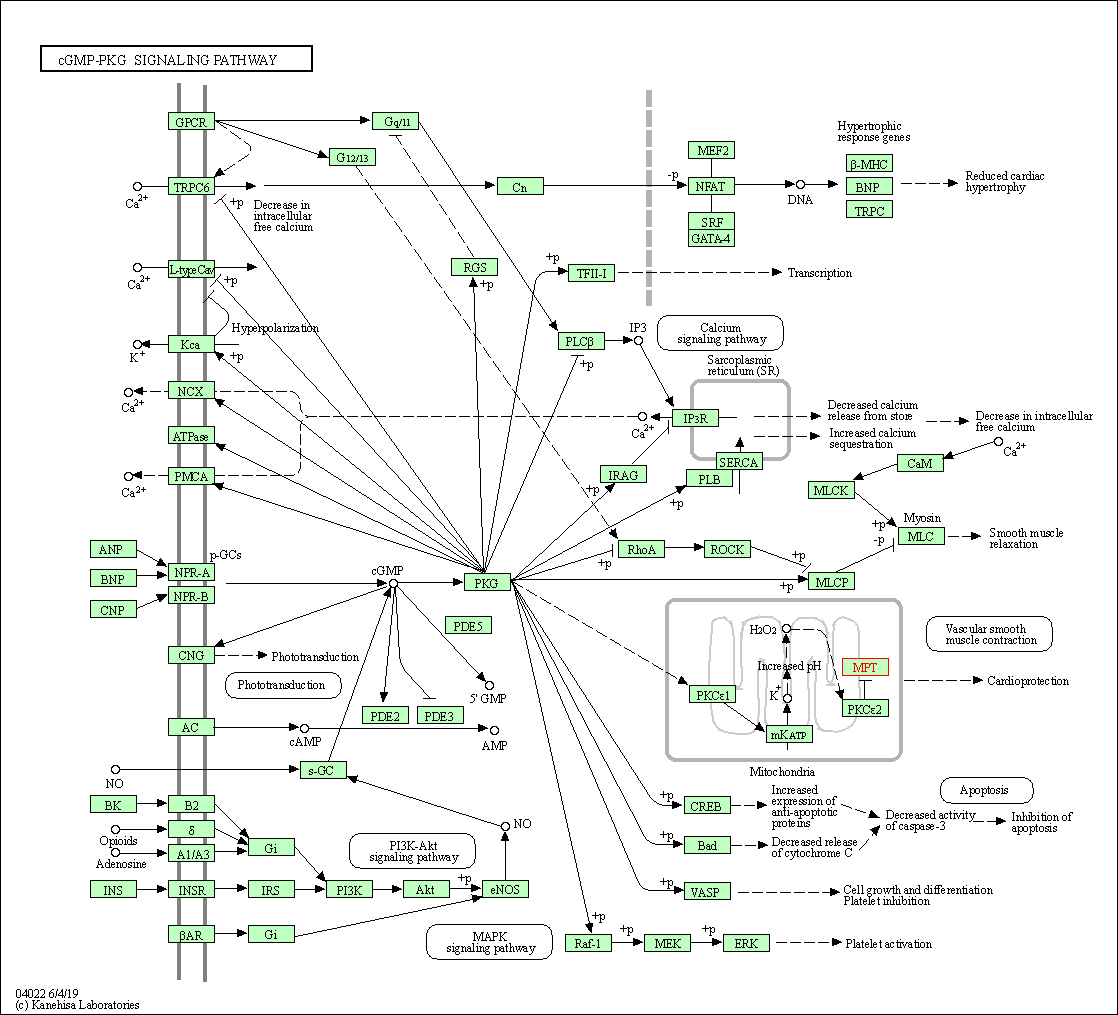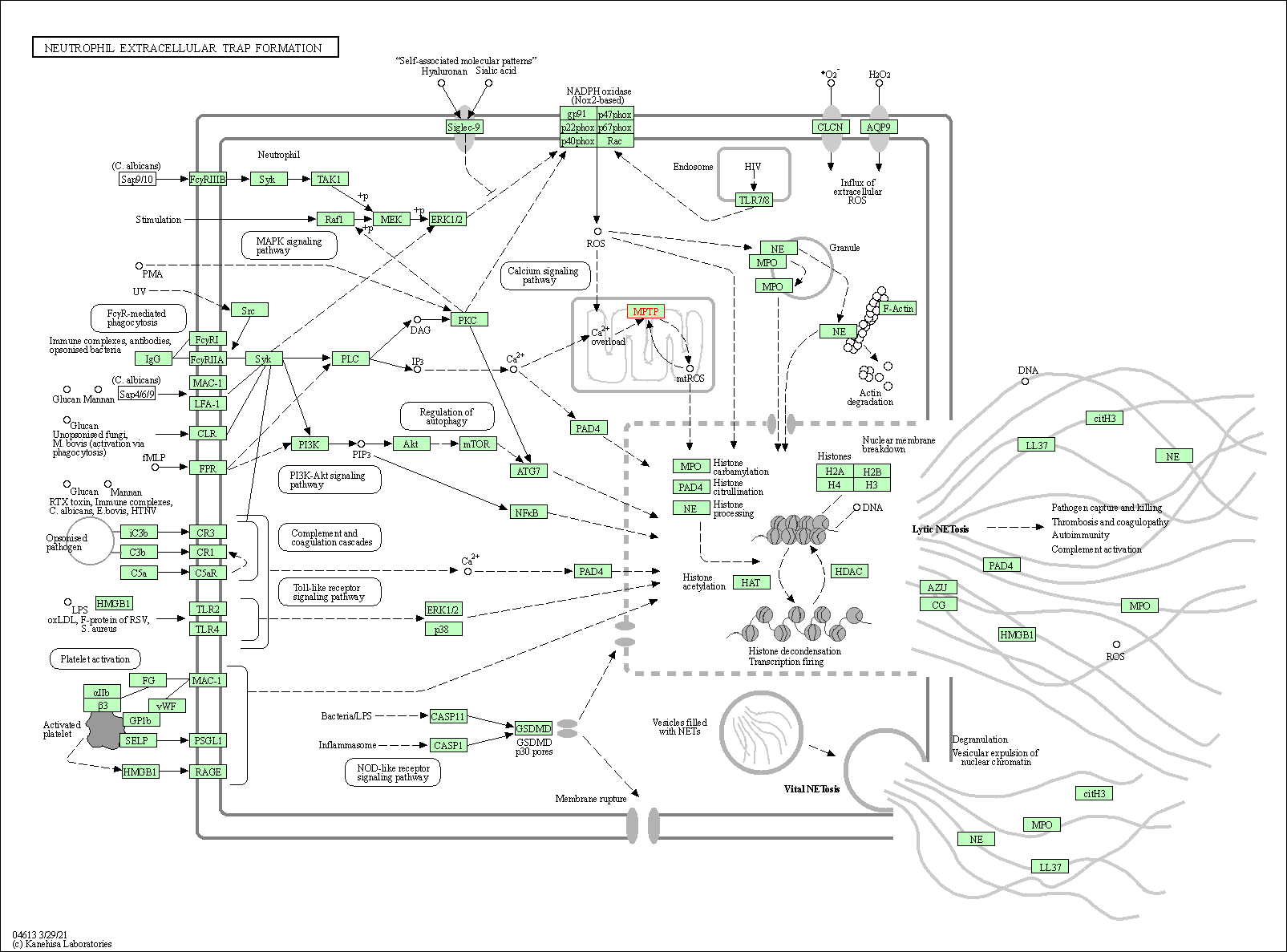Target Information
| Target General Information | Top | |||||
|---|---|---|---|---|---|---|
| Target ID |
T62746
(Former ID: TTDI02437)
|
|||||
| Target Name |
Rotamase F (PPIF)
|
|||||
| Synonyms |
Peptidylprolyl cistrans isomerase F, mitochondrial; Peptidyl-prolyl cis-trans isomerase F, mitochondrial; PPIase F; Mitochondrial cyclophilin; Cyclophilin F; CyPM; CyP-M; CyP-D; CYP3
Click to Show/Hide
|
|||||
| Gene Name |
PPIF
|
|||||
| Target Type |
Literature-reported target
|
[1] | ||||
| Function |
Involved in regulation of the mitochondrial permeability transition pore (mPTP). It is proposed that its association with the mPTP is masking a binding site for inhibiting inorganic phosphate (Pi) and promotes the open probability of the mPTP leading to apoptosis or necrosis; the requirement of the PPIase activity for this function is debated. In cooperation with mitochondrial TP53 is involved in activating oxidative stress-induced necrosis. Involved in modulation of mitochondrial membrane F(1)F(0) ATP synthase activity and regulation of mitochondrial matrix adenine nucleotide levels. Has anti-apoptotic activity independently of mPTP and in cooperation with BCL2 inhibits cytochrome c-dependent apoptosis. PPIase that catalyzes the cis-trans isomerization of proline imidic peptide bonds in oligopeptides and may therefore assist protein folding.
Click to Show/Hide
|
|||||
| BioChemical Class |
Cis-trans-isomerase
|
|||||
| UniProt ID | ||||||
| EC Number |
EC 5.2.1.8
|
|||||
| Sequence |
MLALRCGSRWLGLLSVPRSVPLRLPAARACSKGSGDPSSSSSSGNPLVYLDVDANGKPLG
RVVLELKADVVPKTAENFRALCTGEKGFGYKGSTFHRVIPSFMCQAGDFTNHNGTGGKSI YGSRFPDENFTLKHVGPGVLSMANAGPNTNGSQFFICTIKTDWLDGKHVVFGHVKEGMDV VKKIESFGSKSGRTSKKIVITDCGQLS Click to Show/Hide
|
|||||
| 3D Structure | Click to Show 3D Structure of This Target | PDB | ||||
| Cell-based Target Expression Variations | Top | |||||
|---|---|---|---|---|---|---|
| Cell-based Target Expression Variations | ||||||
| Drug Binding Sites of Target | Top | |||||
|---|---|---|---|---|---|---|
| Ligand Name: Dimethylformamide | Ligand Info | |||||
| Structure Description | Human cyclophilin D complexed with dimethylformamide | PDB:3RCG | ||||
| Method | X-ray diffraction | Resolution | 0.97 Å | Mutation | Yes | [2] |
| PDB Sequence |
GNPLVYLDVD
53 ANGKPLGRVV63 LELKADVVPK73 TAENFRALCT83 GEKGFGYKGS93 TFHRVIPSFM 103 CQAGDFTNHN113 GTGGKSIYGS123 RFPDENFTLK133 HVGPGVLSMA143 NAGPNTNGSQ 153 FFICTIKTDW163 LDGKHVVFGH173 VIEGMDVVKK183 IESFGSKSGR193 TSKKIVITDC 203 GQLS
|
|||||
|
|
||||||
| Ligand Name: Carzenide | Ligand Info | |||||
| Structure Description | Human Cyclophilin D Complexed with a Fragment | PDB:3R4G | ||||
| Method | X-ray diffraction | Resolution | 1.05 Å | Mutation | Yes | [2] |
| PDB Sequence |
GNPLVYLDVD
53 ANGKPLGRVV63 LELKADVVPK73 TAENFRALCT83 GEKGFGYKGS93 TFHRVIPSFM 103 CQAGDFTNHN113 GTGGKSIYGS123 RFPDENFTLK133 HVGPGVLSMA143 NAGPNTNGSQ 153 FFICTIKTDW163 LDGKHVVFGH173 VIEGMDVVKK183 IESFGSKSGR193 TSKKIVITDC 203 GQLS
|
|||||
|
|
||||||
| Click to View More Binding Site Information of This Target with Different Ligands | ||||||
| Different Human System Profiles of Target | Top |
|---|---|
|
Human Similarity Proteins
of target is determined by comparing the sequence similarity of all human proteins with the target based on BLAST. The similarity proteins for a target are defined as the proteins with E-value < 0.005 and outside the protein families of the target.
A target that has fewer human similarity proteins outside its family is commonly regarded to possess a greater capacity to avoid undesired interactions and thus increase the possibility of finding successful drugs
(Brief Bioinform, 21: 649-662, 2020).
Human Tissue Distribution
of target is determined from a proteomics study that quantified more than 12,000 genes across 32 normal human tissues. Tissue Specificity (TS) score was used to define the enrichment of target across tissues.
The distribution of targets among different tissues or organs need to be taken into consideration when assessing the target druggability, as it is generally accepted that the wider the target distribution, the greater the concern over potential adverse effects
(Nat Rev Drug Discov, 20: 64-81, 2021).
Human Pathway Affiliation
of target is determined by the life-essential pathways provided on KEGG database. The target-affiliated pathways were defined based on the following two criteria (a) the pathways of the studied target should be life-essential for both healthy individuals and patients, and (b) the studied target should occupy an upstream position in the pathways and therefore had the ability to regulate biological function.
Targets involved in a fewer pathways have greater likelihood to be successfully developed, while those associated with more human pathways increase the chance of undesirable interferences with other human processes
(Pharmacol Rev, 58: 259-279, 2006).
Biological Network Descriptors
of target is determined based on a human protein-protein interactions (PPI) network consisting of 9,309 proteins and 52,713 PPIs, which were with a high confidence score of ≥ 0.95 collected from STRING database.
The network properties of targets based on protein-protein interactions (PPIs) have been widely adopted for the assessment of target’s druggability. Proteins with high node degree tend to have a high impact on network function through multiple interactions, while proteins with high betweenness centrality are regarded to be central for communication in interaction networks and regulate the flow of signaling information
(Front Pharmacol, 9, 1245, 2018;
Curr Opin Struct Biol. 44:134-142, 2017).
Human Similarity Proteins
Human Tissue Distribution
Human Pathway Affiliation
Biological Network Descriptors
|
|
|
There is no similarity protein (E value < 0.005) for this target
|
|
Note:
If a protein has TS (tissue specficity) scores at least in one tissue >= 2.5, this protein is called tissue-enriched (including tissue-enriched-but-not-specific and tissue-specific). In the plots, the vertical lines are at thresholds 2.5 and 4.
|
| KEGG Pathway | Pathway ID | Affiliated Target | Pathway Map |
|---|---|---|---|
| Calcium signaling pathway | hsa04020 | Affiliated Target |

|
| Class: Environmental Information Processing => Signal transduction | Pathway Hierarchy | ||
| cGMP-PKG signaling pathway | hsa04022 | Affiliated Target |

|
| Class: Environmental Information Processing => Signal transduction | Pathway Hierarchy | ||
| Neutrophil extracellular trap formation | hsa04613 | Affiliated Target |

|
| Class: Organismal Systems => Immune system | Pathway Hierarchy | ||
| Degree | 11 | Degree centrality | 1.18E-03 | Betweenness centrality | 1.32E-03 |
|---|---|---|---|---|---|
| Closeness centrality | 2.50E-01 | Radiality | 1.43E+01 | Clustering coefficient | 1.64E-01 |
| Neighborhood connectivity | 6.16E+01 | Topological coefficient | 1.09E-01 | Eccentricity | 10 |
| Download | Click to Download the Full PPI Network of This Target | ||||
| Target Regulators | Top | |||||
|---|---|---|---|---|---|---|
| Target-regulating microRNAs | ||||||
| References | Top | |||||
|---|---|---|---|---|---|---|
| REF 1 | Loss of cyclophilin D reveals a critical role for mitochondrial permeability transition in cell death. Nature. 2005 Mar 31;434(7033):658-62. | |||||
| REF 2 | Fragment-based discovery of a new family of non-peptidic small-molecule cyclophilin inhibitors with potent antiviral activities. Nat Commun. 2016 Sep 22;7:12777. | |||||
If You Find Any Error in Data or Bug in Web Service, Please Kindly Report It to Dr. Zhou and Dr. Zhang.

